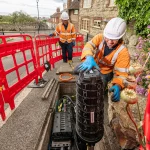Update on IPv6 Plans for Virgin Media, TalkTalk, Plusnet and Vodafone

A number of our readers have been asking for an update on the progress being made by several major UK broadband ISPs, including TalkTalk, Vodafone, Plusnet and Virgin Media (VMO2), toward the deployment of the “new” IPv6 internet addressing standard. Sadly only one provider was able to give a rough launch date.
Internet protocol (IP) addresses exist to help connect you and your devices or software with others around the online world – like an ID number for your connection. Unfortunately, the IPv4 address space could only handle 4 billion addresses and that supply has been exhausted (except for the resale of existing address pools), which means that in the future ISPs will need to use the new IPv6 standard in order to continue adding new connections without compromise (e.g. IP address sharing / CGNAT is a compromise that can cause problems).
Sadly, the longer form IPv6 addresses are not directly compatible with older IPv4 addresses and so the two will need to be run side-by-side for many years to come (i.e. until the vast majority of the world has enabled IPv6). Happily, there are various ways to resolve this challenge, but some providers have been dragging their feet for years.
Advertisement
At present many of the market’s smallest ISPs have already adopted IPv6 as a seamless part of their networking and, at the larger end of the scale, BT and Sky Broadband enabled it a long time ago. By comparison, TalkTalk, Vodafone, Plusnet and Virgin Media seem to have struggled and this week we sought an update. Just for fun, we’ll include both the 2019 comment from each ISP below and their latest comment.
Virgin Media
Back in 2018 it appeared as if VM were set to adopt the Dual Stack Lite (DS-Lite) approach to running IPv4 and IPv6 side-by-side (here) and the first customer trials began by around the middle of that same year (here), although DS-Lite does have its downsides and some of those may have occurred during the trial.
In 2019 some of our sources indicated that VM had opted to put on hold or scrap DS-Lite and go with a full Dual Stack approach instead, but after two years of waiting.. well, we’re still waiting.
A VM Spokesperson told ISPreview.co.uk in 2019:
“We are currently setting out our IPV6 deployment plans and will provide an update at the appropriate time.”
A VMO2 Spokesperson told ISPreview this week:
“We are continuing to plan our IPV6 deployment having tested several solutions and intend to introduce IPV6 for our customers in future.”
Vodafone
During late 2019 Vodafone seemed confident that they would be able to fully implement IPv6 by the spring of 2020, which was no doubt hampered by the COVID-19 pandemic. But it’s now 2021 and the pandemic is no longer an acceptable excuse. The good news is that they now expect fixed broadband connections to get IPv6 support in 2022, at some point.
Advertisement
A Vodafone Spokesperson told ISPreview.co.uk in 2019:
“We are well into planning and will have fully implemented it by late spring next year.”
A Vodafone Spokesperson told ISPreview this week:
“The role out of IPv6 has taken longer than we initially anticipated – it is now scheduled to be fully implemented next year.”
Plusnet
The fact that Plusnet still doesn’t have support for IPv6, despite being a part of the BT group and using the same hardware (routers etc.), has always been somewhat of a peculiarity. Not to mention that in 2011 they were one of the first ISPs in the UK to trial it and even urged the rest of the industry to follow their lead (here). All of that now seems rather comical.
In 2019 Plusnet, much like Vodafone above, predicted they’d be ready to launch IPv6 in the spring of 2020, but due to the pandemic that never happened. Today, the ISP that first trialled IPv6 a decade ago, says there are still “a few more things we need to do” before it goes live, and they don’t seem able to give a clear indication of when that will be.
A Plusnet Spokesperson told ISPreview.co.uk in 2019:
“We’re committed to the roll out of IPv6, as this an important evolution for our networks and the service we provide our customers. We’re in a good place with our internal testing which means we are hoping to start making this available to customers in Spring next year.”
A Plusnet Spokesperson told ISPreview.co.uk this week:
“There are a few more things we need to do before we can enable IPv6 on the Plusnet broadband network. We are still committed to the roll-out and hope to make good progress over the coming year.”
TalkTalk
Historically, getting any kind of IPv6 update out of this ISP has been incredibly difficult and, until 2019, they often gave us the silent treatment whenever we asked. Not much has changed. We nudged TalkTalk several times for a comment last week and, despite receiving and acknowledging our messages, they could not provide a response. Instead, here’s what they said in 2019.
A TalkTalk Spokesperson told ISPreview.co.uk in 2019:
“TalkTalk is committed to transitioning to IPv6. To minimise any potential impact to our customers and services, the transition will be phased over the next few years as we roll-out new products and services such as fibre to the premises.
We continue to work closely with our network and systems vendors to ensure all new equipment is fully IPv6 compliant. In fact, our network already operates as dual stack, using IPV4 compliant addresses while the major network components are IPV6 ready.”
Take note that most of these ISPs still retain a sizeable pool of spare IPv4 addresses, and so may not feel as much pressure to adapt. Meanwhile, others may try to stretch this out by adopting IP address sharing (e.g. Carrier Grade NAT), although that approach is rarely desirable given the problems that it can sometimes create with internet connectivity and security.
Advertisement
In terms of consumers, most rarely pay much attention to how their internet connection works under the hood and so would have little reason to demand IPv6 support from their ISP. Suffice to say, broadband ISPs like those above will not be feeling any particular pressure to adapt, even though it does give the impression that their systems may not be particularly cutting edge.
Mark is a professional technology writer, IT consultant and computer engineer from Dorset (England), he also founded ISPreview in 1999 and enjoys analysing the latest telecoms and broadband developments. Find me on X (Twitter), Mastodon, Facebook, BlueSky, Threads.net and Linkedin.
« Gigaclear Complete GBP21m West Oxfordshire Full Fibre Rollout
BT Test Robots to Help Build and Fix UK FTTP Broadband Ducts »






















































https://imgur.com/a/OZBd2jR
Spot on 🙂
Very Good, I liked the Pictures
So will this mean TV Programmes like NCSI will have to start using IPV6 addresses instead of version 4? 😉
You can’t beat a good ‘role out’. It’s up there with ‘on sight servicing’.
> NOTE: An IPv4 address looks like this: 217.160.165.202, while the equivalent IPv6 is: 0:0:0:0:0:ffff:d9a0:a5ca (shortened)
Hmm, if you’re trying to show the IPv4 address as an IPv4-mapped IPv6 address, then it would be
::ffff:217.160.165.202
That’s 96 bits of prefix with the remaining 32 bits for the IPv4 address.
A ‘proper’ IPv6 address looks like
2001:db8::dead:beef:cafe
I went with 0:0:0:0:0:ffff:d9a0:a5ca as it mapped to the domain properly and was closer to a regular IPv6, but you’re of course correct, there are different formats to IPv6. I didn’t want to do a big additional explainer on this side of things though, as that wasn’t the focus of the article.
Hopefully this is a good sign virgin is actually working on IPv6 https://jamesmacwhite.medium.com/have-virgin-media-enabled-ipv6-sort-of-9443e5e855d
What about EE? Still not enabled despite using rebranded BT kit.
EE is a story of two halves, as they’ve already done a lot on IPv6 via their mobile platform. I’ll ask about fixed broadband next week.
https://www.ispreview.co.uk/index.php/2018/10/mobile-network-operator-ee-uk-sees-surge-in-ipv6-deployment.html
Bit of a non-story IMHO. For a start 99% of your average internet users won’t even know what IPv6 is, never mind have a need for it. Its really only users like IT users who can’t live without ipv6, the rest of the population can manage perfectly fine with ipv4 addresses. Worth remebering the big ISPs have a huge allocation of ipv4 addresses – something which the smaller ISPs don’t – so they’re not going to be running out of ipv4 addresses anytime soon. But I’m fairly sure the remaining major ISPs will roll out ipv6 well in advance of when they’re about to run out of ipv4 addresses.
Most users don’t know what IP is in general, but that doesn’t remove their need for it. Specifically thinking about IPv6, I’ve noticed that a number of websites load faster than over IPv4. My hypothesis is that they are IPv6-only and add IPv4 support via a reverse proxy (e.g. https://www.mythic-beasts.com/blog/2015/10/05/ipv4-to-ipv6-reverse-proxy-load-balancer/), but this is difficult to prove.
So can you tell me what a non-IT user can do – wrt day to day internet usage – over IPv6 what they can’t do over IPv4?
We have already run out of IPv4 addresses https://www.ripe.net/publications/news/about-ripe-ncc-and-ripe/the-ripe-ncc-has-run-out-of-ipv4-addresses
You are also ignoring the server end of connections. If I want to provide a service to users I still have to buy IPv4 addresses which generally means a small /29 range which can be expensive. Would Love to be able to just use IPv6 on my servers which is essentailly free. I can’t though as not all the major ISP’s support IPv6 and I need the majority of users to be able to connect.
@ Jeff Smith
Well clearly the big IPv4 only ISPs still have enough IPs to go around. Or you suggesting that they’ve been unable to provide IPs for new customers?
@jeff
You could run a million websites / http servers behind a single ip.
The requirement for 1 ip for 1 web server was demolished a long time ago. Reverse proxies are an essential tool in service delivery enabling greater security, availability and throughput.
It’s why ipv4 exhaustion is always spoken about in terms of end user connections as that is where demand is.
While the ip registries have exhausted their allocations, there are still ranges that could be allocated like the 240/8 class e’s or even huge numbers of /8’s assigned to organisations or businesses like ibm’s 9/8 (yes q 9 have a /24 in there).
@mike I’m not talking about the big UK ISP’s im talking the pool of addresses for people that want to host servers in a datacenter. I would like to move to IPv6 but cant until the majority of ISP’s actully support it.
@chris I do host multiple sites behind a proxy for https traffic but there are lots of services its much harder to proxy like that. Don’t IBM and other big comapnies own those IP address ranges and I’m betting they would want millions to sell them. Every time I ask for a range of IP addresses it getting more and more expensive for shorter ranges. IPv6 on the other hand I get given for free and instead of 8 addresses I get millions.
and do you think “most users” read this website? I mean I rarely see non-medical staff thumbing through a copy of the BMJ. Irrelevant point. You are completely wrong about it being “IT users”. Many mobile phone networks hand out a v6 IP. Many major telco networks run their networks on IPv6. The rest of the population is not “perfectly fine” with IPv4 because they’re running out and because ISPs have to start doing stupid tricks like CGNAT because they don’t have enough IPs. You go tell the kid that can’t get his xbox or PS5 to play because of CGNAT that it’s “perfectly fine” according to you. And what of the person who wants another IP ? Can’t have one.
You haven’t got a clue about IPv6, as is evident by your post.
Another kid that connected mommy and daddy’s ISP router and is now a “network engineer” online.
Nice rant Randy! FYI none of the mainstream fixed line ISPs use CGNAT so your point about CGNAT is irrelevant.
Calm down Randy. I never said that ISPs won’t/shouldn’t roll out IPv6 as everyone and their dog knows that IPv4 addresses won’t last forever. However right now major fixed line ISPs – what this ispr article is about – provide a perfectly usable ipv4 static/dynamic address which lets the average user game/shop/stream porn without any issues. The only fixed line ISP I know of that use CGNAT as standard is Hyperoptic but even then they offer the user to purchase a a static ipv4 address to get around any gaming issues. It really isn’t a big deal to use a non-CGNAT ipv4 address for day to day internet activities for the ordinary user.
Wider v6 deployment is a crucial step to getting content and service providers onto v6 as well – it’s a bit chicken and egg but one side has to move first. New ISPs to the market are deploying CGNAT (Hyperoptic, Community Fibre’s lower speed packages) which can result in increased numbers of CAPTCHA forms being presented and issues with online gaming that has a P2P element to it.
IPv6 is the future (well, the present I guess), the equipment that ISPs are using fully supports it, a native deployment will perform better than running through NAT. There’s no good reason not to deploy it.
> So can you tell me what a non-IT user can do – wrt day to day internet usage – over IPv6 what they can’t do over IPv4?
Play https://loopsofzen.uk/
IPv4 version here
http://www.alproductions.us/Loops_Of_Zen/Loops_Of_Zen/Welcome.html
Switched from Plusnet to Zen about 18 months ago after firstly getting fed up of constant price haggling and also their lack of IPV6 rollout.
Now I’ve got IPV6 it’s allowed me to more easily setup access to various things at home from externally, especially in conjunction with cloudflare obfuscating the real addresses and also providing a proxy IPV4 address for all those ISP stuck in the 90s
Hi Mark – a part of the story you’ve not mentioned is cost.
For newer Altnets – who do not have an existing large pool of IPv4 addresses – the cost to buy them is growing linearly year on year. This is because the address space is exhausted so it is now a market for recycled addresses which are growing increasing scarce as the hyper scale cloud providers hoover them up.
You need at least one public address per subscriber (2 if you need one for your VoIP ATA as well as your WAN interface) and current pricing can be as high as $38-40 per address.
See price trend graphs at https://ipv4marketgroup.com/ipv4-pricing/
You also need to buy these c6months in advance of your user base needing them so that you can quarantine them so they fall of any blacklists. This represents a very significant up front cost for a smaller ISP.
Can’t charge for IP addresses. You might have to pay an “admin fee” for someone to enter something into a database, once .. but if someone charges for IP addresses then that’s not permitted.
@philip – many business ISPs already do charge monthly for IPv4 addresses! Hyperoptic are the only residential ISP I’m aware of that charge to be allocated a public non cg-Nat address.
I wonder how long ISPs will be allowed to sell “internet” connections without enabling connectivity to the IPv6-internet?
Probably for as long as they’ve been able to sell “fibre” package with an old twisted pair or coax coming to your home.
The UK government should just do an IPv4>IPv6 cut off date like it does everything else. If we had of relied on the TV operators to manage the Terrestrial to Digital TV switch over we’d still have terrestrial TV now with constant promises of “we will do it, we’re working on it”.
it’s not up to the UK Gov though. And god help us if it were … they haven’t got the knowledge to understand something like this. Case in point, go look at how many gov departments have IPv6 endpoints, hint: none.
God no thanks. The government have no jurisdiction on IP address assignment and god help us all if they did. They haven’t got the competency to do it even if they wanted to, case in point go have a look how many government websites have IPv6 endpoints. Hint: none.
ugh sorry about the duplicate comment. It said “duplicate comment detected” when I posted it… but upon refreshing the page there was no comment at all.
IPv6 is the climate change denial of the computer science world. They just don’t care. VM for example could switch it on with the flick of a switch. But they don’t. What’s the matter are hexadecimal strings too much for you to work with?
Absolutely pathetic.
Indeed. Except “climate change” doesn’t exist. The Earth is 4-4.5 billon years old and isn’t going to explode if you don’t buy lots of things from billionaires.
The same teenagers who scream about global warming and you’re killing us all. Also want the latest Iphones every single year just to look cool.
@Ted, what on earth are you talking about? Climate change is an anthropological concern, not a geological one. The earth will do just fine, it’s us humans we should be worrying about…
@Anthony, if you genuinely think that, then you are supremely out of touch with reality.
And yet there are places like Kingston University with a /16
They’ve got more IP addresses than students and last time I was there they even gave things like printers a real IP.
Perhaps RIPE should claw back all these giant swathes of IP address landscape from places like universities. There’s no need for a uni to have 65,534 IP addresses when it has 24,000 students and many of them are part time. Oh and no need for their halls of residence to give all the students a real IP either. If they want to port forward, they should pay for an IP.
Ah, Kingston Ufinersity.
Christ that takes me back to unhappy times. I worked there for 6(?) months – delighted to leave. Clueless doesn’t do it.
Bear in mind Kingston’s history wrt JANET hence the massive block of IP.
Giving devices real IP’s must be a security nightmare. What is the point anyway? Why give a device that shouldn’t be externally visible a real full IP? I’m lost for words. Mind you, they probably do it because they have always done it and they can do it and it is still controlled by a bloke with no qualifications and Brill Cream in his hair.
I’m being slightly tongue in cheek but only slightly.
IPv6 addresses are real world addressable too & yes security nightmare.
Many organisations had public ipv4 addresses decades ago and used them as they where meant to back then for things like servers, printers, client machines etc. the world changed in between but there was no need to re-ip essential systems because people started using rfc 1918 internally. Re-ip’ing thousands of long lived internal systems is risky and expensive especially when they are bespoke and no one knows how to amend the apps to talk to the original systems but in new addresses.
Most businesses who had IT operations that started at least in the 90’s will likely have public IP’s internally.
My ISP UnchainedISP do have ipv6! I am surprised Plusnet are lack of it for far too long.
I know that there are problems when migrating users on an existing IPv4 network to IPv6 without causing some disruption, but what I find disappointing is that when ISPs build new networks – e.g. FTTP – they don’t implement IPv6 from the start. e.g. Gigaclear don’t offer IPv6 (although some of their resellers do). They are just creating problems for the future – yet claim to be “future-proof”.
This is disappointing, especially as parts of the larger groups have experience of IPv6 (e.g. Vodafone in DE). Govt. policy does play a part – it would be easy to mandate IPv6 for central govt. use, and I can only imagine the waste and mess that’s accumulating in NHS.
For consumers, I’ve designed a couple of consumer IoT systems and both had issues with CGNAT. But it’s hard to make enough noise when most subscribers just consume media.
There also seem to be quite a lot of naivety over the cost of s/w migration: too many s/w stacks cannot parse IPv6, let alone handle the different topological assumptions in best practice.
Zen has it for years. It is funny that VM/O2 are struggling while UPC in Poland (same Liberty Global group) has it implemented for years.
What is needed is some big companies (such as BBC, Google, Microsoft, Amazon etc) to say they will only be accessible via IPv6 from this date. Governments can’t do it, but the endpoints will. Each of those places have enough pull that it will force ISP’s to get their fingers out.
Yes, but it would be naive to think the likes of Google really care about ipv6 all that much, enough to force ISPs. What’s on it for them? They have more ipv4 than they need.
> What is needed is some big companies (such as BBC, Google, Microsoft, Amazon etc) to say they will only be accessible via IPv6 from this date.
That’s really the nub of the issue. Content providers are all about eyeballs: eyeballs = customers+advertising = money.
Content providers can reach all their customers on IPv4, but only a fraction of their customers on IPv6. So they are forced to make their content visible on IPv4, and see little reason to make it available dual-stack on IPv4+IPv6 (even though it’s easy to do so).
Making content IPv6-only is not an option. If a major content provider like BBC did that, they’d cut off most of their audience.
IMO what’s needed is deployment of IPv6-only *client* networks with NAT64 to reach the rest of the Internet – instead of the RFC1918+NAT44 we see today. The big CDNs like Google, Akamai and Cloudflare could NAT64 the entire IPv4 Internet, making it accessible to IPv6-only clients.
What is the technical reason we can’t extend IPv4 to numbers up to 999 per octet? e.g. having an IP like 999.123.456.789 ? I’m sorry for not being an expert I just wondered why it is we can’t just extend the existing one if the limit for each octet is 255 due to it being 32 bit?
Just update some software surely? Also it’s been a long time since my IT lessons but weren’t there also some “reserved” ranges in the IPv4 address space? can we not use those?
You can’t store 999 in 8 bits. If you have to edit the software of every single device in the world to get “IPv4 release 2” working on it then you might as well just go to IPv6.
Each octet is 8 bits.
All ipv4 software especially at low driver level expects ipv4 packets in the correct format so it knows how to extract the key info to move the packet or retrieve its content. You can’t just arbitrarily change the number of bits in the address without updating all systems that packets will pass through. The only thing you can do is make a new standard like ipv6 and run both in parallel.
At the hardware level, not software, equipment has a 32 bit register that they apply subnet mask to.
It wouldn’t be just a software change on any router that has hardware acceleration, they’d need to either be replaced entirely or have all their line cards swapped out.
IPv6 has already been implemented on this kit.
> I just wondered why it is we can’t just extend the existing one if the limit for each octet is 255 due to it being 32 bit?
It seems you have a misconception that the addressing limitation is related to 32-bit vs. 64-bit CPU architectures — this is not the case, it’s just coincidence that the number “32” appears in both contexts.
The IPv4 protocol was designed to use addresses that are 32-bit numbers. That means there are 2^32 ≈ 4.3 billion unique addresses. These addresses are merely commonly represented in the form a.b.c.d, where each segment represents 8 bits of the full address. The protocol cannot just be changed in situ; to change the address length means creating a new protocol; this (among other reasons) is the purpose of IPv6.
Creating hardware/software stacks that support IPv6 and getting them into the hands of ISPs and consumers alike is only part of the problem (and one that has long been solved). Once an ISP has been assigned an IPv6 address block, they then need to create a new IPv6 network that runs alongside their existing IPv4 network, and connect all of their existing customers to it. That is the tedious task that these ISPs are putting off or having trouble completing.
A sad tale –
Back in the early 80s a group of researchers at Lancaster University working with UCL and ARPA asked me to get them some IP addresses for their work. I contacted ARPA, who in those days controlled the addresses, and asked for a block. They said, sure do you want a class A or B? Well it was only a small research group and 65K is a lot of addresses so I said a B would be fine!
I think that ranks along with who needs more than 640K of memory. Equally interesting would be for someone to value a Class A in todays climate!
It was to try and keep routing tables small. A full table is ~900,000 routes now. Can’t imagine how expensive the RAM would have been to hold all that in the 1980s, how many RUs you’d need to hold equipment to take all that RAM or how long it would take to converge a table that size.
It’s unfortunate there’s no mechanism to recover all those addresses doing nothing. One entity I know that has an enormous amount of IPv4 has migrated largely to IPv6 internally. They use a tiny fraction of their v4 allocation.
Yep, I’m old enough to remember the effort involved in keeping the global routing tables <512KB (I think it was) because that was the maximum memory partition size for them in the Cisco routers that everyone used back then.
As an aside, gotta love the "just update some software" solutions being punted on here….
People still talk about keeping routing tables small now days too on internal systems, I’ve no idea why when ram is cheap and the lower end processors they’ve used over the years are more than capable of supporting a full global table.
For global tables,
If you assume that 1 route entry is 1kb, then 1m is 1GB. Not every system is a border router and not every system needs to support the full global table so the requirement for a full table is only for a few specific routers that should be less than 5 years old and should have more than enough capability, it doesn’t need to be hardware and could happily be a virtual platform.
https://blog.apnic.net/2021/03/03/what-will-happen-when-the-routing-table-hits-1024k/
Had it on sky for years with no problem and now with Zen. Works a treat. Others seem to be dragging their heels on this.
ISPs that don’t provide IPv6 support are already essentially selling a second class service.
New businesses wanting to enter the market are faced with a real challenge in terms of accessing sufficient IPv4 addresses. Other commenters have already mentioned that newer market entrants such as Hyperoptic and Community Fibre are being forced to use CGNAT which can be a real PITA for end users, so their offerings are less than ideal.
We’re seeing a marketplace that is increasingly becoming skewed in favour of larger/older service providers that have IPv4 addresses available and can afford to drag their heels because it is giving them a market advantage. I’d argue that this is an issue which the Government could and perhaps should address: choosing not to implement IPv6 is essentially anti-competitive. Setting a cut-off date by which all telecoms outfits needs to support IPv6 is a no-brainer.
Mark, you may be interested to know that a TalkTalk Business sales staff informed me that TalkTalk’s IPv6 would launch in June of 2022.
Uno also has no plans for IPv6 afaik, but it is always possible to use a tunnel like https://www.tunnelbroker.net to bridge the gap.
DS-Lite is a fairly poor idea, especially for those of us who are security concious enough not to use the routers supplied by the ISP! I, for instance, use an enterprise grade firewall directly connected to the modem. DS-Lite would force me to upgrade to another generation of firewall.
Obviously there are other options, I’m currently using PlusNet, but I use a V6 in V4 tunnel.
Best thing to do, if you can, is just leave. I was getting sick of the virgin hub 2 WiFi going down and up all the time, crashing completely, needing rebooting. They sent out a hub 4 which is obviously even worse, won’t permit a whole load of port forwards claiming that they are “reserved”, so it won’t forward port 25 for incoming email for instance. Absolutely useless. So I told them to pretty much shove it where the sun don’t shine.
Shortly before then Openreach had put fibre cabling into the street ducts so I said “Yes PLEASE” to Zen Internet. They answer the phone with a real person and get you connected pretty much immediately with a FIXED IPv4 address and set you up with IPv6 upon request (email late one evening, IPv6 operating early next morning) and they don’t give a damn what router you use so they also supply the fibre termination box login details for PPPoE. I have a choice of either TP-Link Archer C7 or Xiaomi AC2350 both running up to date OpenWRT. I’m mostly living alone so the basic 100 meg is fine for me, streams from iPlayer etc. faultlessly.
Very happy with this, now waiting for the virgin cable TV to die.